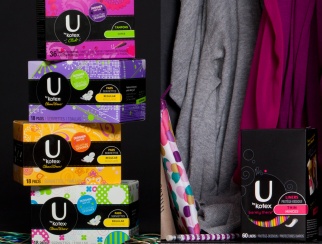This article was published in the November 2016 issue of STORES Magazine.
New York City-based CBX is a consumer branding firm providing a range of strategic and creative services. As executive creative director, Allison Koller is responsible for providing inspiration, vision and strategic guidance for the CBX design team. She has led creative and innovation initiatives for such clients as Kimberly-Clark, General Mills, Burt’s Bees and The Art of Shaving.
Most recently, Koller led her team to a Platinum Pentaward for packaging work on behalf of U by Kotex (Kimberly-Clark). And it’s marketing to women that inspires Koller. In a June TEDx talk in Scotch Plains, N.J., Koller described herself as a swimmer, illustrator, daughter, tennis player and wife who pays keen attention to the content and subtext of brand messages aimed at women.

Allison Koller, Executive Creative Director, CBX, New York City
You said brands need to move beyond the “sea of clichéd visual codes” if they want to connect with real women. Can you give us examples of the “tired tropes,” as you call them?
I think the most clichéd codes present women as perfect — no flaws allowed. By presenting women without imperfections, we’ve set up an unrealistic standard where women can’t get real. There’s no sweat or blemishes, no aging and perfectly run households. There are no individuals with real thoughts or feelings represented.
Among the most common clichéd codes I’ve found is “magic.” The word is used with products that promise to make you flawless, or forget any challenges women may face. Another one is the “Ingénue.” She’s an innocent — usually blonde — woman that never ages. The “Goddess” is either perfectly sculpted from a sweat-free workout or wearing a sparkling gown. We’ve all seen “Modern Miracle Mom” with her house in order, dinner on the table, perfect birthday parties and blogging about all of it. Unfortunately, we still find references to the “Exotic,” a still-all-too-common representation of women of color as mysterious, sultry or fiery.
Tired tropes include the sea of eyes, belly buttons, breasts and beautiful booties. Messages and images with the power to break through that sea are unexpected. They make you look twice. They shift the cultural conversation.
What brands have been successful in shifting the cultural conversation?
Fortunately, some brands understand the need to keep it real. I think U by Kotex started a new type of dialog. Kotex wanted to transcend the clichéd codes of feminine hygiene: Girls back-flipping on the beach while having their period, levitating tampons twirling in front of a sea of flowers. They recognized the need for a new conversation with young women that broke through the “pretty-princess, flowery noise” of the category. We launched with something undeniably code- and cliché-breaking — the black box with a touch of fun in the brightly colored wrappers. No flowers, no high-tech performance claims.
Elsewhere in the category, we’re seeing it in the “Like a Girl” campaign from Always (Procter & Gamble) that addresses the plummeting self-esteem girls experience around the same time that they get their period. Thinx has upped the ante with its “period proof” underwear. Both Kotex and Thinx have taken a rebellious stance. They’re pointing out shortcomings and double standards of the category and culture. That’s allowing them to open up a more honest and real conversation about women’s health and, in particular, having a period. You just have to ask yourself, if our culture can accept open dialog about erectile dysfunction, why not periods?
Are there others worthy of note?
Outside the feminine care category, the health and fitness space has made a shift to embrace real women. Under Armour has stepped up community building through social media. Its “What’s Beautiful” campaign cast amateur female athletes as strong warriors that supported one another. They also expanded the definition of athlete to include ballet dancer Misty Copeland and with supermodel Gisele Bündchen fighting off harsh online criticism in the “I Will What I Want” campaign. It was an inspirational way for them to reach women.
In cosmetics, a true pioneer is Dove with its “Real Beauty” campaign. Dove’s tireless commitment to the platform, expanding upon it year after year to make a more inclusive definition of beauty, has inspired so many other brands. You can also see it in American Eagle’s Aerie brand. They made a commitment to not retouch their models’ [photographs] and to use young women who fall outside the super-slim standard. Campaigns like this start to shift the culturally accepted definition of “beautiful woman” from perfect to real.

So how do you measure success when connecting with “real” women and not some idealized version? Does social media play a role? What about the physical retail environment or online commerce?
I think response in social media is definitely a barometer of success. The “#LikeAGirl” video [has] received more than 60 million views worldwide since 2014 and it’s actually having a positive effect on boys as well. The campaign also netted Procter & Gamble a double-digit increase in product sales. Under Armour paired its “What’s Beautiful” with pop-up workout events around the country, so they were able to directly connect with their customer. When women are actively engaging and sharing pieces of their experience, a real connection is made.
But a great retail experience isn’t specific to women. Creating an open environment with places to connect to community or have an experience that can’t happen online will ultimately make the difference. Lululemon’s retail model is a prime example. The store doubles as a yoga studio.
While not traditional retail, SoulCycle is another fitness brand that has created a tribe of women that are T-shirt wearing, yellow nail-painting brand evangelists. Toms Shoes is not specific to women, but it’s unquestionably real in its commitment to social responsibility. Toms’ “One for One” program permeates all communications. It’s an underpinning to the retail environment where people can hang out with free Wi-Fi, drink some Toms coffee, attend a yoga class and, of course, browse for shoes and sunglasses. The brand’s core consistency allows it to expand in many directions and make real connections with both women and men.
What advice do you have for brand marketers hoping to create campaigns that resonate with real women? You mentioned, for example, notions of “perfection” giving way to imperfection. Can you share a few thoughts?
I would urge any brand to take a risk and change the conversation. Show women a more inclusive and inspirational — not just aspirational — picture of the world. Rather than representing the “Ingénue,” embrace aging in all its beautiful forms. Women can work hard to get results as warriors, not only goddesses. “Magic” is taking a back seat to hard work. The “Modern Miracle Mom” has shifted to homemaking with everyday dads and gender role reversals. Instead of exoticism, we have true diversity.
Expand the definition of family — look at the recent Tylenol and HoneyMaid campaigns — by flipping gender roles and depicting same-sex partnerships. If that sounds too scary, it really shouldn’t, because we’re talking about real life. It comes down to finding the message that’s true to a brand. Next is defining how it can authentically connect with women in a space beyond the cliché, and then living up to that message every single day.